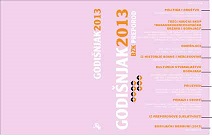Arhitektura etnosimulacruma i turbofolk potkultura: supstituiranje bosanskog kulturnog naslijeđa krivotvorinama
ARCHITECTURE OF ETHNO SIMULACRUM AND TURBO FOLK OF SUBCULTURE: SUBSTITUTING OF BOSNIAN HERITAGE BY FORGERIES
Author(s): Amra HadžimuhamedovićSubject(s): Museology & Heritage Studies
Published by: Bošnjačka zajednica kulture "Preporod"
Keywords: Bosnia; architectural heritage; simulacrum; copy; counterfeit; fictive; ethno-village
Summary/Abstract: This paper is intended to provide a possible scientific objectification of simulacra in contemporary Bosnian architecture, expressed in the form of copies, forgeries and fiction. By analyzing instances of the replicating the existing buildings of great symbolic value, of conjectural and fictive reconstructions of buildings demolished a century or more ago, and of architectural simulations of history that never was by the forms of the modern architectural hybrids known as ethno-villages, two key motives for the ethno-simulation of cultural heritage can be identified: 1) the financial gain to be obtained from large-scale ethno-branded tourism; 2) the supstitution or new construction of identity, exclusivist demarcation of ethnoterritory and remodelling of Bosnia’s historic urban landscapes. The definition of the different levels of borrowing or betrayal of the cultural heritage in Bosnia is based on the categories suggested by Jean Baudrillard in his list of stages of sign-order from faithful image to pure simulation. The appearance of ethno-simulacra in recent Bosnian architecture has a direct impact on the cultural heritage, being constituted on the distortion of the meaning of Bosnian cultural memory, on its devaluation and direct physical destruction (either by giving the archaeological remains of a building a veneer of fictive architecture or plundering the heritage sites for new simulations of historic architecture). This phenomenon, that has local attributes of a subculture, found its first major expression in Serbia in the early 21st century, and is based entirely on the context of the origins, content and sociological significance of the music known as turbofolk. Almost a decade and a half since significant forms of ethno-simulation were first registered in the Bosnian architecture, it is fair to describe is as an architectural and social trend and to consider its impact on the cultural heritage. The ethno-simulacrum trend in Bosnia is comparable with some on-going phenomena in various other parts of the world, particularly that of heritage copies and mimicry in the post-socialist countries of the former Soviet Union and post-communist China, but may also be set in the global context of events characterized as instigating a paradigm shift in cultural heritage protection in general.
Journal: Godišnjak Bošnjačke zajednice kulture »Preporod«
- Issue Year: 2013
- Issue No: 1
- Page Range: 221-238
- Page Count: 18
- Language: Bosnian

